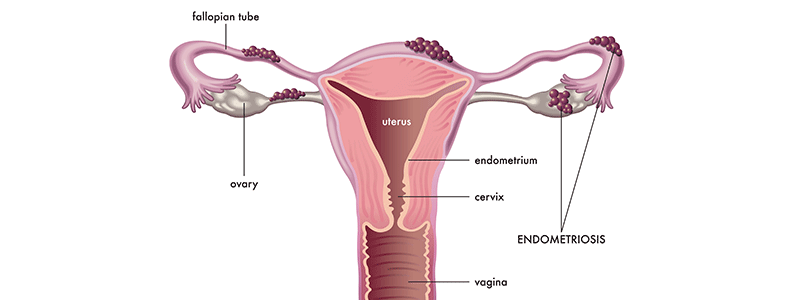Adolescent endometriosis is an inflammatory condition in which the lining of the uterus (the endometrium) is found growing outside of the uterine cavity, such as on the bowel, the bladder or the lining of the uterus and ovaries.
Overview
What is adolescent endometriosis?
Endometriosis can cause varying degrees of pain. Endometriosis is a leading cause of infertility. This is why early diagnosis and treatment is key in preserving your child’s ability to get pregnant later in life.

Signs and Symptoms
What are the signs and symptoms of adolescent endometriosis?
Endometriosis can be mild, moderate or severe, and symptoms are different for each person.
Symptoms include:
Bleeding in between periods
Pain in the lower back, pelvis and abdomen
Diagnosis
How is adolescent endometriosis diagnosed?
Testing - Early diagnosis is important to effectively treat endometriosis. Certain tests, such as blood tests or a pelvic ultrasound, may be done to rule out infection or other conditions. Based on the symptoms, signs, and imaging findings, a probable diagnosis of endometriosis can be made.
Laparoscopy - Endometriosis is diagnosed by a laparoscopy procedure. During a laparoscopy, your doctor will insert a thin tube with a lens and light through a small incision in the lower abdomen. This gives the doctor a good view of the inside of the pelvic area and helps determine the location and size of the endometrial growths.
Medication - Sometimes, the doctor can remove the endometrial growths during the laparoscopy; however, such surgery generally does not always improve pain or symptoms in teenagers. Therefore, given the risk of surgery, we instead choose to treat with medications initially.
Causes
What are the causes of adolescent endometriosis?
There is no known cause of endometriosis. But research indicates it does run in families.
Other things that may increase your daughter’s risk include:
Starting her periods at an early age
Heavy or long menstrual cycles
Certain anomalies of the reproductive system
Low body weight
Any history of pelvic infection
Treatment
How is adolescent endometriosis treated?
Hormonal treatments - Used to relieve symptoms and prohibit the endometrial cells from growing.
Pain relief strategies - Exercise and healthy diet as well as over-the-counter medications to help with pain.
Laparoscopic surgery - Surgery is usually accomplished during the laparoscopy, the minor surgical procedure that diagnoses the condition. If the endometriosis is extensive, the doctor may remove it in more extensive surgery called laparotomy.
There is not a cure for endometriosis, but hormone therapy and minor surgery can effectively treat the condition.